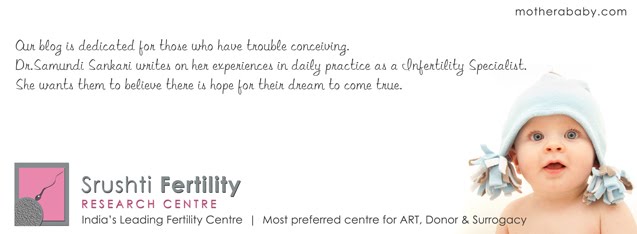Ovarian Cysts / Chocolate Cysts: Types, Diagnosis and Treatment
Ovarian cysts are usually seen in three forms:
* Follicular or Functional Ovarian Cysts
* Corpus Luteal Ovarian Cysts
* Endometrioma or Chocolate Cysts
 What are Follicular Cysts?
What are Follicular Cysts?These are the most common of the benign functional cysts. Each time an egg is produced by the ovary a small cyst forms. The cyst is usually very small and ruptures when releasing the egg during ovulation. If the cysts don't rupture they may continue to grow; however, as they rarely grow larger than 8 centimeters and normally shrink after ovulation, surgery is usually not required. If rupture occurs, pelvic pain may result and last 24-48 hours. The pain is due to a small amount of bleeding which is irritating to the abdominal cavity. Surgery may be indicated in cases when bleeding continues or is excessive.
Treatment:Follicular cysts usually resolve on their own in 3-6 weeks.
What are Corpus Luteum Cysts?These are much less common than follicular cysts. Corpus luteum cysts develop after the ovary releases its egg and the formed follicular cyst changes into a small hormone producing "yellow body", also known as the corpus luteum. If the yellow body reaches a size of greater than 3 centimeters, it is then referred to as a cyst. Rupture of these ovarian cysts occurs more often on the right side, during intercourse and during the later days of the menstrual cycle when the cysts are at their largest. If they grow too large, they may need to be surgically removed.
Smokers have a two-fold increased risk of developing functional ovarian cysts.
Oral contraceptive therapy has been known to markedly reduce the risk of the formation of the functional ovarian cysts.
What are Endometriomas/Chocolate Cysts?This disease process is also known as Endometriosis of the ovaries. Tiny implants of cells that line the uterine cavity become transplanted and form small cysts on the outside of the ovary. These cysts enlarge and produce Endometriosis of the ovary. They respond to hormone stimulation during the menstrual cycle and produce many small cysts, which may then occupy and even replace the normal ovarian tissue.
These endometriomas are filled with a thick chocolate-type material, which is the reason they are known as "chocolate cysts". When this type of ovarian cyst ruptures, the material spills over into the pelvis and onto the surface of the uterus, bladder and bowel and the corresponding spaces between. Adhesions can develop because of this rupture and may lead to pelvic pain.
What are the symptoms of Ovarian Cysts?If these cysts remain small (less than 3 centimeters) no symptoms may result. Cysts larger than 10 centimeters cause the most common symptoms such as pelvic pain, which may present either unilaterally or bilaterally.
As with Endometriosis, pain may be worse at different points throughout the menstrual cycle. If these cysts rupture and peritoneal implants are present, the same type of debilitating pelvic pain may occur.
Do Ovarian Cysts cause infertility?Endometriomas do not appear to affect egg quality, but they can interfere with follicular development and ovulation. This situation occurs when the endometriomas adhering to the pelvic side wall cause interference with the ovulatory mechanism leading to the ovum (egg) pickup.
How are Ovarian Cysts diagnosed?As with any disease, a known medical history is very important. If a patient with a known history of Endometriosis presents a pelvic ultrasound with a large ovarian cyst, there is a high probability that this will be an endometrioma.
Ultrasonography Studies:Transvaginal and abdominal ultrasounds are the most commonly used tests to diagnosis endometriomas. Transvaginal scanning has the advantage of providing additional information about the internal makeup of the ovarian mass.
These ovarian cysts vary in appearance, from purely cystic to complex with septations, debris or even a solid consistency. This is primarily due to the thick "chocolate" material. A CT scan and MRI are seldom indicated as a primary diagnostic procedure, although if cancer is a strong consideration, using one of these may be helpful.
How are Ovarian Cysts treated?Contrary to Endometriosis, these cysts are primarily an ovarian process. Traditional gynecologists will address ovarian cysts with oophorectomy (removal of ovary), or the radical approach of a hysterectomy.

 uncertain, no side effect or tolerated well when used in limited doses. Homeopathic medications show good records with increased sperm counts and motility. Nutritional foods include fresh fruits and vegetables, grains, nuts like cashew, almonds or walnuts, sweet & juicy fruits such as mangoes, peaches, plums, and pears all can improve fertility of both men and women.
uncertain, no side effect or tolerated well when used in limited doses. Homeopathic medications show good records with increased sperm counts and motility. Nutritional foods include fresh fruits and vegetables, grains, nuts like cashew, almonds or walnuts, sweet & juicy fruits such as mangoes, peaches, plums, and pears all can improve fertility of both men and women.






















